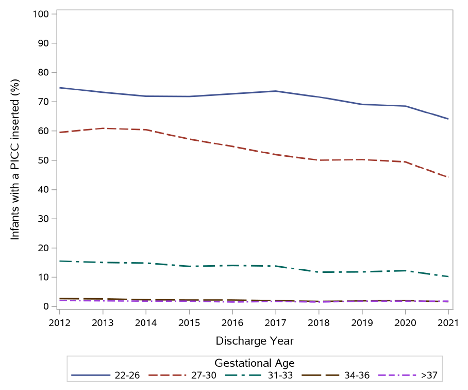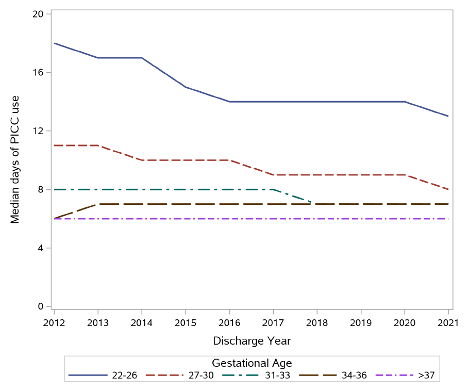Neonatology
Session: Neonatal-Perinatal Health Care Delivery: Practices and Procedures 1
439 - The Changing Incidence of Peripherally Inserted Central Catheter (PICC) Use in Neonates in U.S. NICUs from 2012-2021
Monday, May 6, 2024
9:30 AM - 11:30 AM ET
Poster Number: 439
Publication Number: 439.3191
Publication Number: 439.3191

Thomas Philip (he/him/his)
Student
The University of Texas at Austin
Dallas, Texas, United States
Presenting Author(s)
Background: Use of peripherally inserted central venous catheters (PICCs) is common in the neonatal intensive care unit. A major risk of PICC placement in Central Line-Associated Bloodstream Infection (CLABSI), and daily line assessment is a critical element of bundles and standardized procedures to address this risk. However, there is only limited research on current trends in the use of PICC lines.
Objective: Our objective was to describe trends in the use of PICCs in NICU infants over time.
Design/Methods: This is a retrospective cohort study of inborn infants from the Pediatrix Clinical Data Warehouse, between 2012 and 2021. We excluded infants born < 22 weeks’ gestation at birth, those with major congenital anomalies, and infants transferred out of the network. We evaluated both the frequency of PICC insertion and the total days of PICC use in all infants and within gestational age groups. To control for changes in patient volume, PICC line days were reported per 100 patient days. Data were analyzed with descriptive statistics and trend analysis.
Results: Of 608,078 patients in the CDW, we identified 56,588 (9.3%) who received a PICC line during their NICU stay. We found an overall decrease in the utilization of PICCs from 8.4 to 5.0 line days/100 patient days from 2012 to 2021 (figure 1). The frequency of PICC line insertion decreased over time, from 6,591 patients (11.7%) in 2012 to 4,501 (8.0%) in 2021 representing a 32% relative decrease (figure 2). The median length of each PICC line course also decreased across gestational age groups (figure 3.).
Conclusion(s): Over the past 10 years, there has been a 40% relative decrease in overall PICC line utilization owing to both fewer insertions as well as shorter PICC courses. We plan to further evaluate the trends of decreasing PICC line use, and their possible implications for reducing CLABSIs in neonates.
.png)


